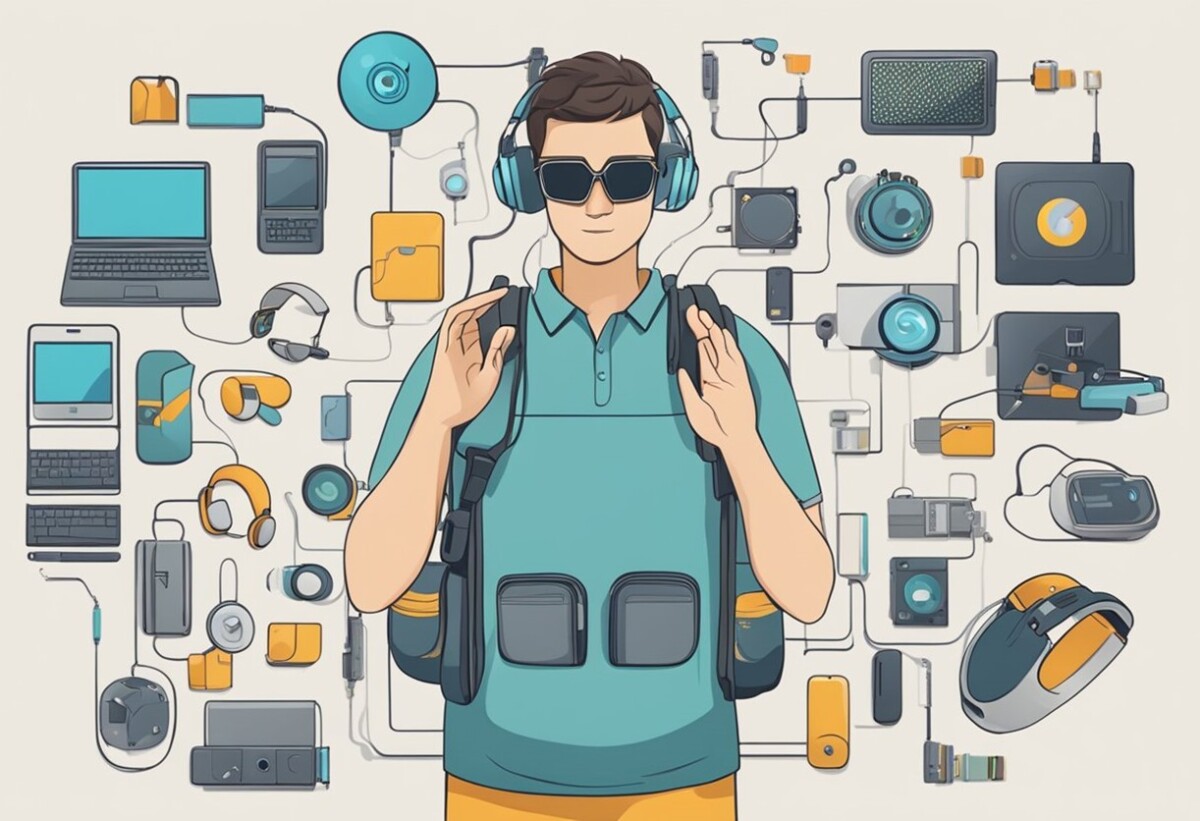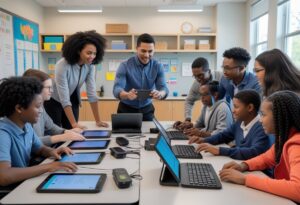Exploring Wearable Technologies for the Deaf-Blind Community

Innovations and Impact of Wearable Technologies People who are Deaf-Blind
Innovations in Accessibility and Independence
As we immerse ourselves in the world of assistive technology, we understand the unique challenges the deaf-blind community faces in accessing information, navigating their surroundings, and engaging with others. Wearable technologies offer innovative solutions that significantly enhance daily independence and accessibility for individuals in this community. By harnessing the potential of these technologies, we can bring a sense of empowerment and autonomy to those who need it most.
From advanced communication devices that translate environmental cues into tactile feedback to GPS-enabled wearables that assist with navigation, the impact of these tools cannot be overstated. Wearable technologies have become instrumental in bridging the gap between the barriers faced by the deaf-blind community and the desire for independence.
Our mission at New England Low Vision and Blindness is to provide life-changing resources that restore hope and improve the quality of life for those who are visually impaired. By embracing the leading-edge innovations in wearable technology, we strive to offer viable solutions that pave the way for greater accessibility and integration into everyday life.
Discover NuCaption: Real-Time Solutions for the Deaf-Blind Community
 Empower communication with NuCaption, the innovative tool designed specifically for the Deaf-Blind community. This real-time captioning solution transforms the way individuals interact with the world, providing clear, accessible, and immediate text translation during conversations. Whether you’re at a meeting, in class, or enjoying social events, NuCaption bridges the gap and fosters inclusive environments.
Empower communication with NuCaption, the innovative tool designed specifically for the Deaf-Blind community. This real-time captioning solution transforms the way individuals interact with the world, providing clear, accessible, and immediate text translation during conversations. Whether you’re at a meeting, in class, or enjoying social events, NuCaption bridges the gap and fosters inclusive environments.
Learn more and explore how NuCaption can transform your experience today. Visit our product page NuCaption – Real-Time Solutions for the Deaf-Blind Community or watch our video.
Exploring Wearable Technologies for the Deaf-Blind Community
Understanding Deaf-Blindness
Deaf blindness involves a dual sensory impairment that impacts both hearing and vision, presenting unique communication and navigation challenges. The condition varies widely among individuals, requiring personalized solutions. Communication tools and technologies offer ways to enhance social interaction and mobility.
The Spectrum of Deaf-Blindness
Deaf-blindness exists on a broad spectrum. Some individuals may retain partial hearing or sight, while others experience profound loss in both senses. This diversity requires tailored approaches for effective support and engagement. Assistive technologies like tactile systems and Braille devices can significantly aid communication and daily activities. These tools help users interpret environmental cues and improve interaction.
Challenges in Communication and Navigation
Communication and navigation challenges are central to deaf-blindness. Individuals often rely on tactile sign language, Braille, and leading-edge communication tools to interact with their surroundings. Navigating public spaces with reduced sensory input adds complexity. Innovative technologies offer solutions to these challenges, empowering users by improving accessibility and safety. These advances ensure that people can maintain independence and engage with their environment effectively.
Evolution of Assistive Technologies
Assistive technology has undergone a remarkable transformation, extending from traditional tools like Braille to advanced digital aids powered by artificial intelligence. These innovations enhance accessibility and independence for individuals with disabilities. Here, we explore two crucial aspects of this evolution.
From Braille to Digital Assistance
The journey of assistive technology began with inventions like Braille, which empowered individuals with vision impairments to read and write independently. Braille displays have evolved significantly, integrating with computers and mobile devices. This adaptation allows users to access real-time information, connect online, and communicate effectively without barriers.
Digital technologies have also introduced text-to-speech and voice-controlled devices, providing alternative ways for individuals to interact with their environments. We at New England Low Vision and Blindness strive to provide diverse solutions that cater to the unique needs of our community, bringing hope and independence through leading-edge assistive technologies.
Integration of Artificial Intelligence
Artificial intelligence represents a transformative force in assistive technologies. AI-powered tools, like smart hearing aids and communication devices, enhance the lives of the deaf-blind community by facilitating seamless interactions. Machine learning algorithms continually improve device performance, adapting to individual user preferences and environments.
AI’s predictive capabilities enable more responsive and intuitive assistive devices, helping users navigate complex tasks with greater ease. Our role at New England Low Vision and Blindness is to harness these innovations, ensuring they’re accessible to those who need them most. Through training and personalized support, we empower individuals to leverage technology for a more connected and inclusive life.
Wearable Devices for Enhanced Accessibility
Wearable devices offer transformative possibilities for enhancing accessibility, especially for the deaf-blind community. Smart glasses and haptic feedback systems are among the leading technologies bringing independence and convenience to users. These devices allow for improved interaction with the environment, ultimately supporting more independent living.
Smart Glasses and Interactive Interfaces
Smart glasses provide an interactive interface that translates visual data into audio, text, or tactile signals. Equipped with AI-driven cameras and sensors, they recognize faces, text, and objects, enabling users to navigate and engage independently. Nucaption Real-Time Solutions complements this by offering instant speech-to-text captioning with tactile feedback and braille compatibility, further enhancing communication and quality of life for the deaf-blind community
Smart glasses convert visual data into accessible audio, text, or tactile cues using advanced AI. This enables users to navigate and engage independently. Additionally, Nucaption Real-Time Solutions offers instant speech-to-text captioning with tactile feedback and braille display compatibility, empowering the deaf-blind community with seamless, real-time communication.
Tactile and Haptic Feedback Systems
Tactile and haptic feedback systems provide valuable alternatives to auditory feedback, especially beneficial for individuals who are deaf-blind. These technologies translate environmental cues and digital information into vibrations or other forms of tactile feedback. This approach allows users to understand spatial and situational contexts through touch.
Such systems can be embedded in wearable devices like gloves or vests, which transmit signals to the skin. For example, a navigation system might alert a user to an obstacle by vibrating in a specific pattern or location, thereby warning them of what’s ahead.
These tactile signals are crucial in environments where audio cues are insufficient. By incorporating these feedback systems, we strive to ensure that the deaf-blind community has access to resources that foster empowerment and autonomy.
Connectivity and Independence
Wearable technologies offer significant potential for the deaf-blind community by enhancing connectivity and promoting independence. By integrating tools with mobile and smart home systems, and by providing autonomous navigation solutions with obstacle-detection capabilities, individuals can experience a newfound freedom.
Mobile and Smart Home Integration
The integration of mobile devices with smart home technology provides deaf-blind individuals with enhanced control over their environment. Mobile applications can connect wirelessly to smart home systems, enabling residents to manage lighting, thermostats, and security features using intuitive, tactile interfaces. This functionality allows greater independence, as users can adjust their living spaces without assistance.
We focus on providing solutions that sync seamlessly with smart devices, empowering users to perform everyday tasks effortlessly. Sophisticated alerts can be set on mobile devices to vibrate when someone rings the doorbell or when there’s a change in room conditions. This fosters a more self-reliant lifestyle, ensuring users can navigate their home environments with ease and confidence.
Autonomous Navigation and Obstacle Detection
Autonomous navigation tools, such as the Sunu Band, utilize advanced technologies to aid movement and obstacle avoidance. These wearable devices employ ultrasonic technology to detect obstacles, alerting users through haptic feedback. This ensures safe navigation without a guide, bolstering the independence of the wearer.
By incorporating these devices into daily routines, individuals can enjoy enhanced mobility and confidence. Combined with our expertise in training and technology, we help users leverage these powerful tools to improve their quality of life. Through leading-edge navigation aids, we open pathways for the deaf-blind community, providing them the tools needed to traverse their worlds safely and independently.
Ensuring Inclusion Through Design
Exploring wearable technology for the deaf-blind community requires a thoughtful approach to design. Prioritizing user-centered design principles and collaborating with the community ensures that these technologies truly meet their needs.
User-Centered Design Principles
When focusing on user-centered design principles, considering the specific requirements of deaf-blind individuals is essential. Wearable devices need to be intuitive and provide value without creating additional challenges. Easy-to-navigate interfaces and meaningful tactile feedback can empower users to engage effectively with their surroundings.
Designing for the deaf-blind community involves understanding their unique experiences. This often requires creating multi-sensory interfaces that blend touch, vibration, and audio cues. Accessibility features like customizable alert settings and adaptable outputs cater to individual preferences and needs, ensuring the technology is inclusive and usable by everyone in the community.
Collaboration with Deaf-Blind Users
Collaboration with the deaf-blind community is vital for creating effective wearable technologies. Engaging with users throughout the design process provides insight into real-world challenges. This collaboration allows us to tailor solutions that address specific issues faced by deaf-blind users, promoting a sense of ownership and engagement.
Partnerships with advocacy groups and organizations offer additional layers of support. By working together, we can develop features that genuinely enhance independence and connectivity. This approach ensures that technology not only meets accessibility standards but exceeds them, leading to a more inclusive experience for deaf-blind individuals.
Exploring Wearable Technologies for the Deaf-Blind Community
Wearable technologies offer promising advancements for individuals with dual sensory loss. We focus on how these devices enhance connectivity, provide effective tactile feedback, aid in navigation, and overcome communication barriers.
What forms of wearable technology currently exist for individuals with a dual sensory loss?
Various wearable technologies are available, including wearable computing devices and smart glasses tailored for those with both hearing and vision loss. These devices help enhance interactions with the environment and improve users’ quality of life by facilitating communication and navigation tasks.
How does tactile feedback in wearable devices assist the deaf-blind community?
Tactile feedback provides essential support by enabling users to receive vital information through touch. This method assists in interpreting data and alerts, making it easier for individuals to navigate their surroundings and recognize immediate needs without relying on visual or auditory cues.
What advancements have been made in haptic technology for aid in navigation for deaf-blind users?
Haptic technology has progressed significantly, with innovations designed to assist in navigation for those who are deaf-blind. Wearables now incorporate features like vibrations and tactile maps that guide users through complex environments in a tactile manner, thereby improving independent movement.
In what ways do smart glasses and similar wearables enhance daily life for those who are deaf-blind?
Smart glasses offer leading-edge features that enhance communication and daily activities for deaf-blind users. These devices can provide visual and auditory information through alternative senses, significantly aiding in tasks such as reading text and understanding sign language.
What challenges do deaf-blind individuals face with current wearable technologies?
Despite numerous benefits, challenges exist, such as the adaptability of technologies to individual needs and the cost associated with obtaining advanced devices. Ensuring that devices provide necessary functionality without being cumbersome remains a focus of ongoing development.
How are communication barriers overcome through the use of wearables designed for the deaf-blind population?
Wearables designed for the deaf-blind can transform communication by converting spoken language into tactile or visual formats. This technology enables smoother interactions, helping individuals connect with others more effectively and fostering greater independence.
Experience Empowerment with Our Deaf-Blind Training
Unlock independence and enhance accessibility with our specialized Deaf-Blind Training services. Whether you’re an individual seeking tailored solutions, an organization striving to create inclusive environments, or a caregiver aiming to support loved ones, our training is designed to provide practical tools and strategies.
👉 Learn More & Get Started Today
Discover NuCaption: Real-Time Solutions for the Deaf-Blind Community
 Empower communication with NuCaption, the innovative tool designed specifically for the Deaf-Blind community. This real-time captioning solution transforms the way individuals interact with the world, providing clear, accessible, and immediate text translation during conversations. Whether you’re at a meeting, in class, or enjoying social events, NuCaption bridges the gap and fosters inclusive environments.
Empower communication with NuCaption, the innovative tool designed specifically for the Deaf-Blind community. This real-time captioning solution transforms the way individuals interact with the world, providing clear, accessible, and immediate text translation during conversations. Whether you’re at a meeting, in class, or enjoying social events, NuCaption bridges the gap and fosters inclusive environments.
Learn more and explore how NuCaption can transform your experience today. Visit our product page NuCaption – Real-Time Solutions for the Deaf-Blind Community or watch our video.



